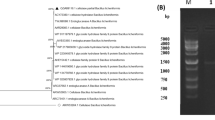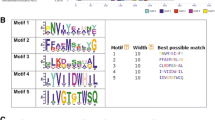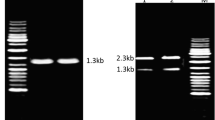Abstract
A bacterial strain with high cellulase activity (0.26 U/ml culture medium) was isolated from hot spring, and classified and named as B. subtilis DR by morphological and 16SrDNA gene sequence analysis. A thermostable endocellulase, CelDR, was purified from the isolated strain. The optimum temperature of the enzyme reaction was 50°C, and CelDR retained 70% of its maximum activity at 75°C after incubation for 30 min. The putative gene celDR, consisting an open reading frame (ORF) of 1,524 nucleotides and encoding a protein of 508 amino acids with a molecular weight of 55 kDa, was purified from B. subtilis DR and cloned into pET-28a for expression. The cellulase production in E. coli BL21 (DE3) was enhanced to approximately three times that of the wild-type strain.





Similar content being viewed by others
References
Lee, R. L., Paul, J. W., Willem, H. V., Zyl, I., & Pretorius, S. (2002). Microbial cellulose utilization: Fundamentals and biotechnology. Microbiology and Molecular Biology Reviews, 66, 506–577. doi:10.1128/MMBR.66.3.506-577.2002.
Rizzatti, A. C. S., Jorge, J. A., Terenzi, H. F., Rechia, C. G. V., & Polizeli, M. L. T. M. (2001). Purification and properties of a thermostable extracellular β-d-xylosidase produced by a thermotolerant Aspergillus phoenicis. Journal of Industrial Microbiology & Biotechnology, 26, 156–160. doi:10.1038/sj.jim.7000107.
Masohiro, N., Masahiro, G., Hirofumi, O., & Yasushi, M. (2001). l-Sorbose induces cellulase gene transcription in the cellulolytic fungus Trichoderma reesei. Current Genetics, 38, 329–334. doi:10.1007/s002940000165.
Watanabe, H., & Tokuda, G. (2001). Animal cellulases, CMLS. Cellular and Molecular Life Sciences, 58, 1167–1178. doi:10.1007/PL00000931.
Goedegebuur, F., Fowler, T., Phillips, J., Kley, P. V., Solingen, P. V., Dankmeyer, L., et al. (2002). Cloning and relational analysis of 15 novel fungal endoglucanases from family 12 glycosyl hydrolase. Current Genetics, 41, 89–98. doi:10.1007/s00294-002-0290-2.
Will, F., Bauckhage, K., & Dietrich, H. (2002). Apple pomace liquefaction with pectinases and cellulases: Analytical data of the corresponding juices. European Food Research and Technology, 211, 291–297. doi:10.1007/s002170000171.
Hiroki, I., Tadanori, A., Keisuke, T., & Yutaka, K. (2005). Heterologous expression and characterization of the endocellulase encoding gene cel3A from the basidiomycete Polyporus arcularius. Mycoscience, 46, 154–161. doi:10.1007/s10267-005-0225-0.
Johnson, E. A., Madia, A., & Demain, A. C. (1981). Chemically defined minimal medium for growth of the anaerobic cellulolytic thermophile Clostridium thermocellum. Applied and Environmental Microbiology, 41, 1060–1062.
Bhat, M. K. (2000). Cellulase and related enzymes in biotechnology. Biotechnology Advances, 18, 355–383. doi:10.1016/S0734-9750(00)00041-0.
Doyle, J., Pavel, R., Barness, G., & Steinberger, Y. (2006). Cellulase dynamics in a desert soil. Soil Biology & Biochemistry, 38, 371–376.
Li, Y. H., Ding, M., Wang, J., Xu, G. J., & Zhao, F. (2006). A novel thermoacidophilic endoglucanase, Ba-EGA, from a new cellulose-degrading bacterium, Bacillus sp. AC-1. Applied Microbiology and Biotechnology, 70, 430–436. doi:10.1007/s00253-005-0075-x.
Herbert, R. A. (1992). A perspective on the biotechnological potential of extremophiles. Trends in Biotechnology, 10, 395–402. doi:10.1016/0167-7799(92)90282-Z.
Paula, S. P., Alexandra, M., José, C. D., Maria, R., Aires, B., & Maria, C. F. (2002). Rapid production of thermostable cellulase-free xylanase by a strain of Bacillus subtilis and its properties. Enzyme and Microbial Technology, 30, 924–933. doi:10.1016/S0141-0229(02)00034-0.
Showale, J. G., & Sadana, J. C. (1978). Cellulase and b-glucosidase production by Basidiomycetes species. Canadian Journal of Microbiology, 24, 1204–1216.
Sambrook, J., Fritsch, E. F., & Maniatis, T. (1989). Molecular cloning: A laboratory manual (2nd ed.). New York: Cold Spring Harbor Laboratory Press.
Teather, R. M., & Wood, P. J. (1982). Use of Congo red-polysaccharide interactions in enumeration and characterisation of cellulolytic bacteria from the bovine rumen. Applied and Environmental Microbiology, 43, 777–780.
Crawford, D., & Mccoy, E. (1972). Cellulases of Thermomonospora fusca and Streptomyces thermodiastaticus. Applied Microbiology, 24, 150–152.
Miller, G. L. (1959). Use of dinitrosalicylic acid reagent for the determination of reducing sugar. Analytical Chemistry, 31, 426–428. doi:10.1021/ac60147a030.
Kim, C. H., & Kim, D. S. (1992). Production and characterization of crystalline cellulose-degrading cellulase components from a thermophilic and moderately alkalophilic bacterium. Journal of Microbiology and Biotechnology, 2, 7–13.
Nazneen, B., & Javed, M. (2003). Characterization of a new Pseudomonas aeruginosa strain NJ-15 as a potential biocontrol agent. Current Microbiology, 46, 324–328. doi:10.1007/s00284-002-3857-8.
Hollien, J., & Marqusee, S. (1999). Structural distribution of stability in a thermophilic enzyme. Proceedings of the National Academy of Sciences of the USA, 96, 13674–13678. doi:10.1073/pnas.96.24.13674.
Te’o, V. S. J., Saul, D. J., & Bergquist, P. L. (1995). CelA, another gene coding for a multidomain cellulase from the extreme thermophile Caldocellum saccharolyticum. Applied Microbiology and Biotechnology, 43, 291–296. doi:10.1007/BF00172827.
Yoshihiro, H., Kenzo, K., Tadashi, Y., Hajimi, M., Tohru, K., & Susumu, I. (1997). Thermostable alkaline cellulase from an alkaliphilic isolate, Bacillus sp. KSM-S237. Extremophiles, 1, 151–156. doi:10.1007/s007920050028.
Robertson, L. D., & Koehn, R. D. (1978). Characteristics of the cellulase produced by the Ascomycete Poronia punctata. Mycologia, 70, 1113–1121. doi:10.2307/3759142.
Zeikus, J. G., Vieille, C., & Savchenko, A. (1998). Thermozymes: Biotechnology and structure–function relationships. Extremophiles, 2, 179–183. doi:10.1007/s007920050058.
Acknowledgments
We gratefully acknowledge the financial support of the National New Productions Project from the Science and Technology Ministry (P. R. China).
Author information
Authors and Affiliations
Corresponding authors
Rights and permissions
About this article
Cite this article
Li, W., Zhang, WW., Yang, MM. et al. Cloning of the Thermostable Cellulase Gene from Newly Isolated Bacillus subtilis and its Expression in Escherichia coli . Mol Biotechnol 40, 195–201 (2008). https://doi.org/10.1007/s12033-008-9079-y
Received:
Accepted:
Published:
Issue Date:
DOI: https://doi.org/10.1007/s12033-008-9079-y




